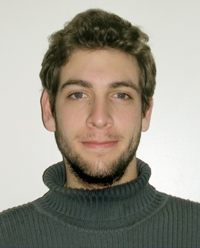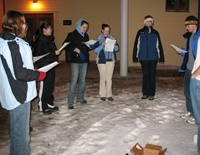How to be a Viking in four short weeks

MIDDLEBURY, Vt. - What does it mean to be a real Viking? Middlebury College senior Ricky Klein knows the answer, and has shared it with the college community. Klein, who has studied Norse mythology since high school, taught a workshop series this month titled “Be a Viking in Four Short Weeks” as part of the college’s non-academic workshop program offered during the month-long winter term each January.
The program, organized by the office of campus activities, includes a series of more than 90 workshops taught by students, staff and others from the college and local community. In addition to such titles as “Charting an International Course for Vermont - A Road Map for Service Learning and Careers” and “Domestic Poverty and the Environment,” many of the workshops covered off beat topics, ranging from “Bagpiping for Dummies,” “Tango” and “Juggling” to “Fly-tying,” “Ice Fishing,” “Mush: Introduction to Dog Sledding” and “Yerba Mate, A Beginners Guide.” Klein’s workshop series explored the every-day life of the Viking and such practices as festival feasts, sauna and burial rituals.

To prepare for his workshops, Klein, a philosophy and religion major, drew on his life-long studies of Icelandic culture and his experiences in Denmark, where he studied during the fall 2005 semester as a junior in the college’s study abroad program. While in Denmark, he searched libraries for texts on Icelandic life, and visited many Viking churches, villages and burial grounds.
The first of Klein’s workshop sessions included discussion of Norse history, people and culture, ranging from historical accounts of the first Christian Viking King Harald Bluetooth, ancestor to the current Queen of Denmark, to stories of early epochs, originally written in Old Norse, called “sagas.” The workshop students read parts of an English translation of Njal’s Saga, or “The Story of the Burning of Njáll,” which is the most famous of these epochs. The students also examined what Klein described as the oldest extant account written of a traditional Viking burial, authored in 922 A.D. by Ibn Fadlan - an Arab writer and member of an embassy of the Caliph of Baghdad - who visited one such event.
The particular focus of Klein’s workshops was every day Viking life, but he also delved into other topics, including the Viking method of trade. According to Klein, Viking trade involved entering a village to trade wares, waiting until nightfall to re-enter the village stealthily and steal back their original items, and then making away with both assortments, the newly traded and the reclaimed goods. “This is why Viking trade is most often referred to as ‘pillaging,’” Klein remarked.
In one session, the students re-enacted the Viking burial described in Fadlan’s account. Klein narrated the tale from Fadlan’s writings, translated into English, while the students performed, outdoors in the winter cold, the roles depicted in the narration. The savage tragedy was scripted by Klein into a milder, symbolic presentation of the alarming elements of the original text. Instead of carving up horses and dogs for the deceased’s burial ship and the ritual defiling of servants in honor of the dead before their sacrificial slaughtering in drunken glory, as is related in the Fadlan tale, the students improvised. Using artistic license and their imaginations, they transformed an old couch into a Viking death ship, which traditionally would have been bedecked with a funereal pavilion. They also created stylized props to represent sacrificial tools.
For the more horrifying scenes of the Viking burial rite, dramatic exit-stage-lefts were directed, with the actors re-entering, appearing to be sad and exhausted. A goldfish - a pet that had died recently - was used to represent the characters of the slain victims in the story. After the re-enactment, the students bowed to each other, and offered up their own applause.
The culminating session of the Viking workshop was a full-day extravaganza on Saturday, Jan. 20, that involved an excursion nine miles - three on foot - into the woods of the Green Mountains to Klein’s previously designated “secret spot.” There, the workshop session incorporated two Viking standards: sauna and feasting.
The students built an eight-foot-square sauna to fit 10 people, and then collected stones to be heated and doused with stream water to create steam. Wood for building the sauna, simple two-by-fours with cedar to line its interior, had been carted to the site on a previous day.
The students also prepared a festival feast of turkey legs, ham and big chunks of hard bread - instead of the more likely Viking fare of spitted ox and roasted herring - to be eaten under the stars with much song, boasting and revelry. In what can be imagined as true Viking style, the hard feasting slowed the completion of the sauna, and the communal sweat scheduled to crown the day was waylaid. The students plan to hike back into the woods with fresh energy on another day to load the sauna with heated stones, and haul water to splash them for a purifying steam.
Klein, who also taught a second workshop at Middlebury this month - in American Sign Language - plans to travel to Iceland after winter term, to continue his study of Norse culture and Icelandic sagas.

